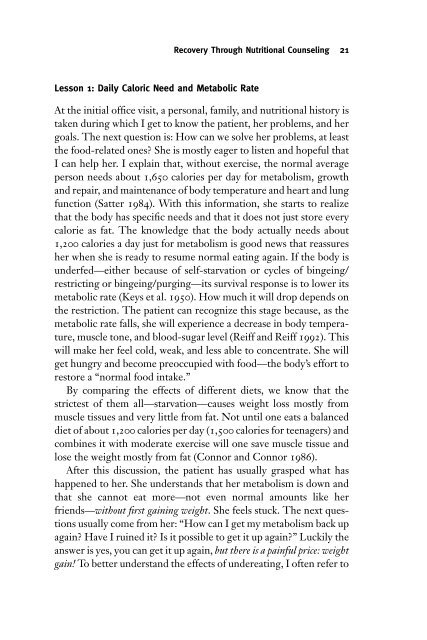Eating Disorders - fieldi
Eating Disorders - fieldi
Eating Disorders - fieldi
You also want an ePaper? Increase the reach of your titles
YUMPU automatically turns print PDFs into web optimized ePapers that Google loves.
Lesson 1: Daily Caloric Need and Metabolic Rate<br />
Recovery Through Nutritional Counseling 21<br />
At the initial office visit, a personal, family, and nutritional history is<br />
taken during which I get to know the patient, her problems, and her<br />
goals. The next question is: How can we solve her problems, at least<br />
the food-related ones? She is mostly eager to listen and hopeful that<br />
I can help her. I explain that, without exercise, the normal average<br />
person needs about 1,650 calories per day for metabolism, growth<br />
and repair, and maintenance of body temperature and heart and lung<br />
function (Satter 1984). With this information, she starts to realize<br />
that the body has specific needs and that it does not just store every<br />
calorie as fat. The knowledge that the body actually needs about<br />
1,200 calories a day just for metabolism is good news that reassures<br />
her when she is ready to resume normal eating again. If the body is<br />
underfed—either because of self-starvation or cycles of bingeing/<br />
restricting or bingeing/purging—its survival response is to lower its<br />
metabolic rate (Keys et al. 1950). How much it will drop depends on<br />
the restriction. The patient can recognize this stage because, as the<br />
metabolic rate falls, she will experience a decrease in body temperature,<br />
muscle tone, and blood-sugar level (Reiff and Reiff 1992). This<br />
will make her feel cold, weak, and less able to concentrate. She will<br />
get hungry and become preoccupied with food—the body’s effort to<br />
restore a “normal food intake.”<br />
By comparing the effects of different diets, we know that the<br />
strictest of them all—starvation—causes weight loss mostly from<br />
muscle tissues and very little from fat. Not until one eats a balanced<br />
diet of about 1,200 calories per day (1,500 calories for teenagers) and<br />
combines it with moderate exercise will one save muscle tissue and<br />
lose the weight mostly from fat (Connor and Connor 1986).<br />
After this discussion, the patient has usually grasped what has<br />
happened to her. She understands that her metabolism is down and<br />
that she cannot eat more—not even normal amounts like her<br />
friends—without first gaining weight. She feels stuck. The next questions<br />
usually come from her: “How can I get my metabolism back up<br />
again? Have I ruined it? Is it possible to get it up again?” Luckily the<br />
answer is yes, you can get it up again, but there is a painful price: weight<br />
gain! To better understand the effects of undereating, I often refer to









